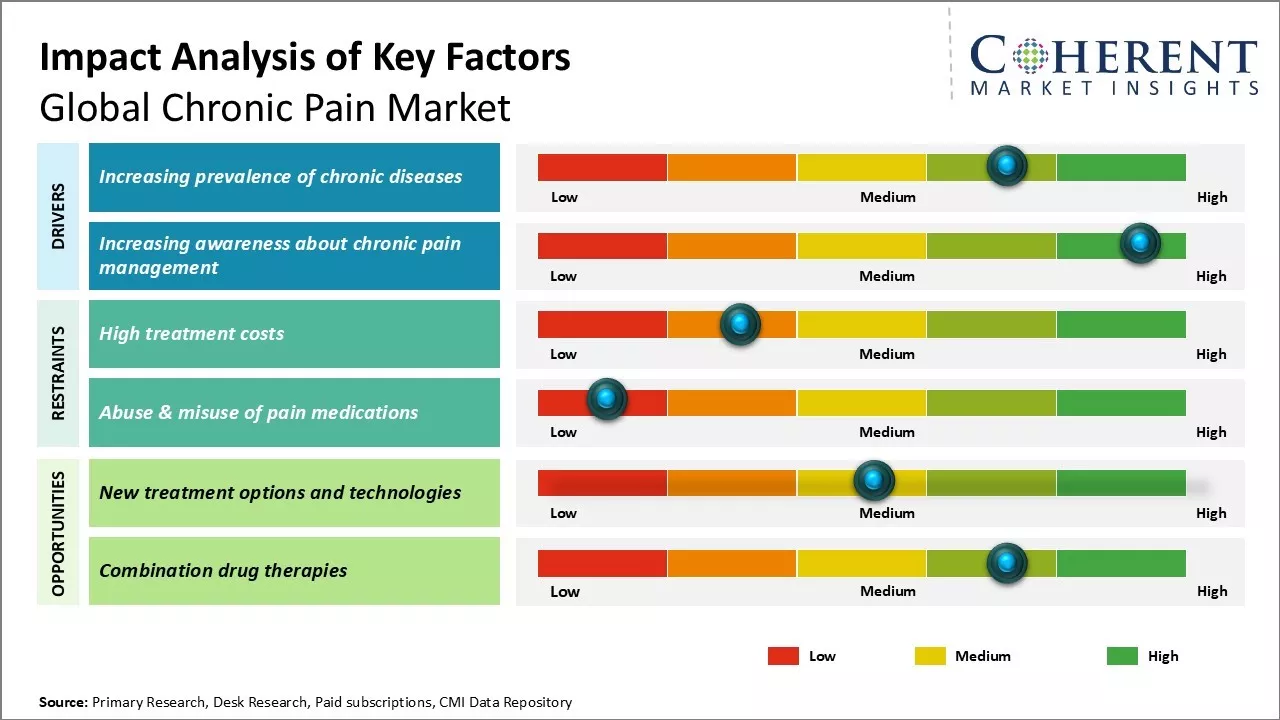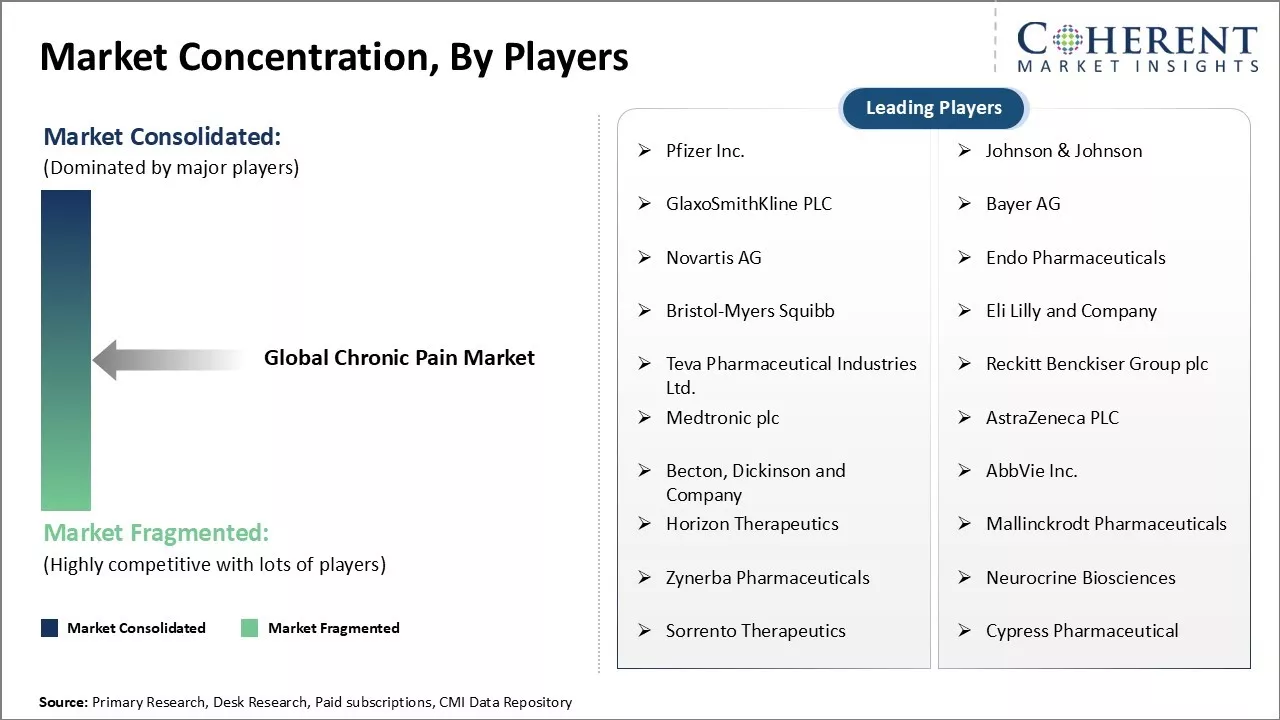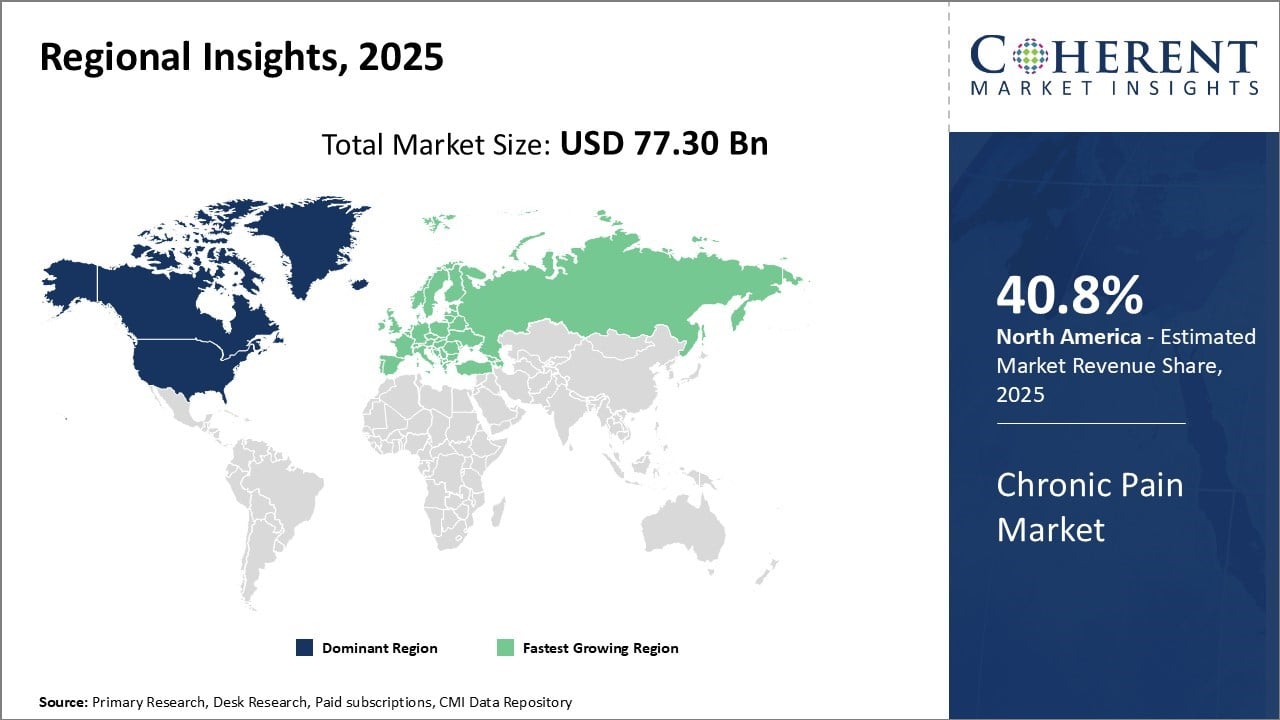Global Chronic Pain Market size is estimated to be valued at USD 77.30 Bn in 2025 and is expected to reach USD 125.84 Bn by 2032, exhibiting a compound annual growth rate (CAGR) of 7.2% from 2025 to 2032.

To learn more about this report, Download Free Sample
The Global Chronic Pain Market forecast is poised for robust growth, primarily driven by the rising prevalence of conditions such as arthritis, fibromyalgia, and neuropathic pain—affecting over 50 million adults in the U.S. alone. An aging global population, expected to reach 2.1 billion aged 60+ by 2050, further amplifies demand for long-term pain management solutions. Therapies like spinal stimulators, for example Abbott’s Eterna, and non-invasive devices like Neuralace’s Axon are changing the way treatment is approached.
The shift from using opioids because of addiction troubles is speeding up the use of non-opioid medications, cannabinoids, and tailored therapies. Moreover, the use of telemedicine and TENS units are changing how pain care is provided. Greater awareness along with policy changes and funding drives are innovation that lead to quicker approvals from regulators. Furthermore, Asia-Pacific and Latin America are emerging markets that are providing more advanced pain care to a vast underserved population. All of these factors are creating a more active and changing approach to managing chronic global pain.
|
Event |
Description and Impact |
|
Regulatory Updates Impacting Opioid Prescribing |
|
|
Geopolitical Supply Chain and Trade Dynamics |
|
|
Technological Innovations in Pain Management |
|
Uncover macros and micros vetted on 75+ parameters: Get instant access to report
Global differences in reimbursement for chronic pain treatment are influenced by national policies, insurance systems, and classification systems. Important diagnostic and procedure codes are ICD-10-CM (with G89.2 for chronic pain), CPT (with 97110 for therapeutic exercises), and HCPCS (with G0283 for electrical stimulation). In the U.S., Medicare reimbursed roughly $3.5 billion and covers 80 percent of chronic pain treatment spending in 2019.
Medicaid expenditures totaled $8.2 billion, but states varied significantly. Private insurers spent a collective $17.8 billion on pharmacologic and non-pharmacologic care. The NHS in the UK fully covers pain therapies, spending £2.1 billion in 2019–2020.
Germany’s SHI spent €4.6 billion providing near-universal coverage, while Japan’s NHI covers only 70% of treatment expenditures at ¥850 billion. China's BMI scheme is more restrictive, with ¥120 billion in spending and high out-of-pocket costs for patients.
Coverage policy is set by regulatory agencies such as the CMS, NHS, SHI, MHLW, and NHSA. There is a global shift, however, toward reimbursement for integrated, multimodal approaches to pain management.

To learn more about this report, Download Free Sample
Rising burden of chronic diseases can drive the market growth. Longer life expectancy and evolving lifestyle trends have largely contributed to this global epidemic. Chronic diseases such as diabetes, arthritis, cardiovascular diseases, and others which were earlier seen as disorders specific to developed nations are now spreading to low- and middle-income countries at an alarming rate.
Due to unhealthy diet, physical inactivity, and tobacco use, more people are becoming susceptible to these chronic conditions at younger ages. Developing countries undergoing nutrition transition are witnessing increase in obesity levels in their populations. This has further accelerated the occurrence of diabetes, joint problems and other chronic diseases. Even though healthcare infrastructure has been improving in these regions, management of chronic diseases poses significant challenges due to limited resources and awareness.
Chronic diseases often coexist with other comorbidities compounding the severity of conditions in affected patients. Diabetic patient is likely to develop hypertension, kidney complications or cardiovascular problems, if diagnosis and treatment is delayed. Mismanagement or lack of support also raises psycho-social issues for people living with chronic pain over long periods. All these factors have contributed to chronic diseases collectively becoming one of the leading causes of morbidity in both developed and developing parts of the world.
Given their irreversible and lifelong nature, the personal and economic burden associated with chronic diseases escalate with time. As more people are diagnosed, there has been increase in need for improved diagnostic methods, safer and cost-effective drugs, rehab measures and assistive devices. Organizations working in the area of chronic disease prevention have strived to raise awareness and initiate campaigns for behavioral change. However, pharmacological interventions remain critical for effective management of existing cases and alleviation of chronic pain symptoms.
Rising awareness regarding chronic pain as a major health issue can drive the market growth. Chronic pain patients now have more resources to understand their condition and seek appropriate support. Advocacy efforts by survivors, medical professionals and policymakers have reduced the stigma around chronic pain. Regular conversations in media and online health communities have normalized discussions on living with and management of chronic pain.
Caregivers are more proactive in identifying signs and symptoms at early stages. People are also adopting preventive measures to dodge risk factors and lifestyle triggers that can potentially induce chronic pain. Healthcare systems worldwide have stepped up to acknowledge pain as the fifth vital sign along with initiatives to improve pain assessment practices. Treatment guidelines now focus on more holistic and multidisciplinary approaches instead of just symptomatic relief. Significant progress has been made to include alternative therapies, educate on safer usage of opioids, emphasize importance of rehab and psyche support.
Patients experiencing persistent pain are no longer expected to simply live with pain. Rising awareness levels have boosted demand for advanced pain relief options whether through drugs, supplements, medical devices or surgeries. Individuals are empowered to make informed choices, try out new lines of treatment and follow up regularly to ensure continuum of care. Various studies show people are more willing to bear out-of-pocket expenses especially when quality of life can be improved.
Development of new and innovative treatment options as well as technologies can offer market growth opportunities. There has been significant research underway to discover novel drugs and drug formulations that can better target the specific mechanisms underlying different chronic pain conditions with improved safety, tolerability and effectiveness profiles. Alternative therapies such as neural stimulation devices, gene therapies and other interventions are also being investigated, which may help manage chronic pain in new ways.
New technologies allowing precision diagnostics, less invasive procedures and remote or home-based care delivery can enhance chronic pain management. Their ability to lower costs of care while maintaining or improving outcomes can address one of the key challenges around high treatment expenditures. Investments into research for new treatments and technologies have the potential to transform chronic pain management.
In terms of drug class, opioids segment is estimated to contribute the highest chronic pain market share of 40.5% in 2025, owing to their widespread and long-term use for treating chronic pain conditions. Opioids are a class of drugs that work by binding to opioid receptors in the brain and spinal cord to reduce the intensity of pain signals reaching the brain. Their ability to effectively relieve both acute and chronic pain has led to increasing dependence on these drugs.
Inadequate treatment options otherwise available for chronic conditions causing severe ongoing pain can boost usage of opioids. Diseases like arthritis, lower back pain and cancer often have no cure and severely impact quality of life. While over-the-counter painkillers provide some relief, these are not strong enough for moderate to severe chronic pain.
This has made opioids as the most potent pharmacological solution licensed for long-term pain management. Furthermore, lack of access to alternative treatments like physical therapy and cognitive behavioral therapy in many countries has made opioids as the mainstay treatment.
Aggressive marketing of prescription opioids by major pharmaceutical companies can also drive the segment growth. Claims that opioids were rarely addictive even with long-term usage led to surge in prescriptions by physicians and reliance on them by patients. While regulations have been tightened, a dependence on opioids for chronic pain management was already entrenched in medical practice and among patients. Socio-economic challenges can increase vulnerability to opioid misuse.
In terms of indication, neuropathic pain segment is estimated to contribute the highest chronic pain market demand share of 35.5% in 2025, owing to its diverse causes and complex pathophysiology. Neuropathic pain occurs due to lesions or diseases affecting the somatosensory nervous system. It is associated with numerous conditions like diabetes, shingles, spinal cord injuries, and trigeminal neuralgia and cancer treatments. Neuropathic pain is often chronic in nature and notoriously difficult to treat due to abnormal hyperexcitability within the nervous system.
The wide range of diseases capable of causing neuropathic changes means it affects a vast population globally. With rising obesity levels and increasing life expectancy, there has been increase in neuropathic pain indications linked to diabetes and neural injuries. Moreover, longer survival rates of cancer patients means more patients experiencing chemotherapy-induced peripheral neuropathy. Their symptoms like burning sensations, allodynia and hyperalgesia demand tailored pharmaceutical management.
Neuropathic pain has proven highly recalcitrant to conventional analgesics due to its unusual pathophysiology. Effective treatment requires drugs specifically developed to target neuronal pathways rather than just general pain relief. The heterogeneity of neuropathic conditions necessitates a wide armamentarium of different drugs classes beyond just NSAIDs and opioids. This has boosted the dominance of the neuropathic pain segment, which depends greatly on newer anticonvulsants, antidepressants and other adjunctive therapies.
In terms of application, musculoskeletal segment is estimated to contribute the highest market share of 52.5% in 2025, due to an aging global population and rising rates of obesity. Musculoskeletal disorders encompass conditions affecting bones, joints, ligaments, tendons and muscles. Chronic pain is a cardinal symptom in arthritis, back injuries, osteoporosis and various degenerative joint diseases.
Advancing age itself is among the strongest risk factors for musculoskeletal complaints and their associated pain. As life expectancy increases worldwide, there will be rise in burden of chronic joint pain caused by age-related changes. Rising obesity prevalence compounds the issue - excessive weight puts stress joints like knees, worsens arthritis severity and frequently causes chronic lower back problems. Developing countries experiencing rapid economic growth and lifestyle shifts to high-calorie diets are now grappling with an obesity pandemic.
Musculoskeletal conditions often require long-term management rather than short-term relief of an episode. Their chronic, degenerative nature means pain medications must deliver efficacious relief without serious adverse effects over many recurring flare-ups. Furthermore, musculoskeletal pain varies widely in location and character necessitating diverse pharmacologic options. This drives dependence on multiple drug classes across antipsychotics, antidepressants, NSAIDs and others for effective polypharmacy treatment regimens tailored to each patient.

To learn more about this report, Download Free Sample
North America is projected to lead the global chronic pain market with a dominant share of 40.8% in 2025, driven by its advanced healthcare infrastructure and strong presence of leading pharmaceutical companies. The United States plays a pivotal role in the region's market leadership, fueled by high patient awareness, increased acceptance of pain therapeutics, and active innovation in drug delivery systems and combination therapies.
Frequent launches of patented, premium-priced drugs further strengthen market growth. However, cost of treatment and regulatory complexities may pose moderate constraints to long-term expansion.
Europe follows as the second-largest region in the global chronic pain market trend, supported by highly developed healthcare systems across key countries such as Germany, the U.K., France, and Spain. Although generic medications enjoy wide adoption, branded drugs still make up a substantial portion of market revenues. Budget constraints and pricing pressures in some countries could impact profitability, while competition from low-cost exports—particularly from Eastern Europe—presents both opportunities and challenges to the region's pharmaceutical landscape.
Asia Pacific is expected to be the fastest-growing region in the global chronic pain market by 2025, propelled by rising healthcare expenditure and growing awareness regarding pain management. Countries like China, India, and South Korea are experiencing rapid economic growth, leading to increased disposable incomes and healthcare access.
Local pharmaceutical manufacturers are benefiting from expanding medical tourism and partnerships with global firms for technology and expertise transfer. While China holds a leading position, India is quickly gaining momentum due to its large patient base, cost-effective production, and supportive government initiatives aimed at boosting generic drug manufacturing.
The United States remains the primary growth engine of the North American chronic pain market, bolstered by its advanced healthcare infrastructure, high prevalence of chronic conditions, and broad access to innovative treatment options. Pharmaceutical companies in the U.S. are actively investing in the development of novel drug delivery mechanisms and combination therapies, leading to the steady introduction of patented products.
Growing awareness among both patients and healthcare professionals regarding chronic pain management supports sustained demand. Despite premium pricing, reimbursement structures and insurance coverage contribute to market stability.
Germany plays a critical role in the European chronic pain market, supported by its robust pharmaceutical sector and well-established healthcare system. The country exhibits a balanced demand for both branded and generic medications, with chronic pain therapies integrated into standard treatment protocols.
Government healthcare spending remains strong, although cost-containment measures and stringent reimbursement policies continue to influence market dynamics. Germany also serves as a key exporter of pharmaceutical products across the EU and beyond, enhancing its industry influence.
China dominates the Asia Pacific chronic pain market, driven by its large population base and expanding healthcare infrastructure. Government policies aimed at improving public access to essential medicines have accelerated the availability of both generic and patented treatments.
The country’s growing pharmaceutical manufacturing capabilities and emphasis on research and development have supported the domestic launch of advanced therapies. Additionally, increasing public awareness and a rising number of specialized pain management clinics are contributing to market growth.
| Report Coverage | Details | ||
|---|---|---|---|
| Base Year: | 2024 | Market Size in 2025: | USD 77.30 Bn |
| Historical Data for: | 2020 To 2024 | Forecast Period: | 2025 To 2032 |
| Forecast Period 2025 to 2032 CAGR: | 7.2% | 2032 Value Projection: | USD 125.84 Bn |
| Geographies covered: |
|
||
| Segments covered: |
|
||
| Companies covered: |
Pfizer Inc., Johnson & Johnson, GlaxoSmithKline PLC, Bayer AG, Novartis AG, Endo Pharmaceuticals, Bristol-Myers Squibb, Eli Lilly and Company, Teva Pharmaceutical Industries Ltd., Reckitt Benckiser Group plc, Medtronic plc, AstraZeneca PLC, Becton, Dickinson and Company, AbbVie Inc., Horizon Therapeutics, Mallinckrodt Pharmaceuticals, Zynerba Pharmaceuticals, Neurocrine Biosciences, Sorrento Therapeutics, and Cypress Pharmaceutical |
||
| Growth Drivers: |
|
||
| Restraints & Challenges: |
|
||
Uncover macros and micros vetted on 75+ parameters: Get instant access to report
*Definition: Global chronic pain market includes the sale of treatments for chronic pain conditions such as back pain, arthritis pain, cancer pain, neuropathic pain and fibromyalgia pain. Chronic pain is generally defined as any pain lasting more than 12 weeks. The chronic pain market comprises of pharmaceuticals like antidepressants, anti-seizure, NSAIDs, opioids and other drugs as well as non-pharmaceutical treatments including medical devices, physiotherapy and psychological therapeutic approaches. Devices used for pain management include neurostimulation devices, analgesic infusion pumps and ablation devices.
Share
Share
About Author
Vipul Patil is a dynamic management consultant with 6 years of dedicated experience in the pharmaceutical industry. Known for his analytical acumen and strategic insight, Vipul has successfully partnered with pharmaceutical companies to enhance operational efficiency, cross broader expansion, and navigate the complexities of distribution in markets with high revenue potential.
Missing comfort of reading report in your local language? Find your preferred language :
Transform your Strategy with Exclusive Trending Reports :
Frequently Asked Questions
Joining thousands of companies around the world committed to making the Excellent Business Solutions.
View All Our Clients